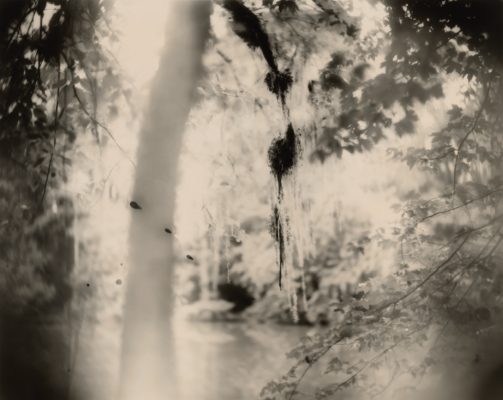Sally Mann: A Thousand Crossings

Sally Mann, Deep South, Untitled (Three Drips), 1998, gelatin silver print, printed 1999, National Gallery of Art, Washington, Gift of the Collectors Committee and The Sarah and William L Walton Fund. Courtesy of Peabody Essex Museum.
Sally Mann: A Thousand Crossings, on view at the Peabody Essex Museum, comprises 115 works across four decades: although not a retrospective, its scope is ambitious. From Mann’s early-career photographs of her children, including a few of her less-controversial nudes and Diane Arbus-like portraits, to her ethereal landscapes and recent images of her husband ravaged by muscular dystrophy, Mann has long surpassed her onetime infamy—a subject explored candidly in her beautifully written memoir, Hold Still.
Mann has lived since birth in rural Lexington, VA, where she eventually came to confront the white privilege that blinded her and so many others to the continued reverberations of slavery and the Civil War. As the exhibition unfolds, one witnesses Mann’s grappling as she shifts simultaneously inward and outward in order to witness the truth and express it as art. As Sarah Kennel, PEM’s Byrne Family Curator of Photography, points out, “She managed to merge two things in photography which are usually separate—spontaneity and narrative.”
In the gelatin silver print Deep South, Untitled (Three Drips), (1998) sun flares and leaf shadows dance above the hazy gleam of water in all its murky stillness. The stain of human tragedy is symbolized by three dark drips that bullet across a ghostlike tree trunk, a counterpoint to the Spanish moss dangling beside it in three Rorschach-like smears. To achieve this and like images, Mann employs chemicals, materials and processes as compositional elements, just as the play of paint, texture and form coalesce in abstract painting as emotional resonance wrought by accident.
The object of Mann’s gaze, whether person, place or the inextricable links between them, is as much the driver of emotional tonality as is her aesthetic interpretation. The Dismal Swamp where Nat Turner hid, the denuded riverbank where Emmett Till washed ashore, fields fossilized by the bones of soldiers, overgrown plantation ruins—although figureless, these images are just as palpable as the portraits of African American men contorted by societal restraint and negative expectation. Mann’s deeply haunting work keeps evolving into evermore complex, original manifestations of her viewfinder and tools in collaboration with her inner eye.
